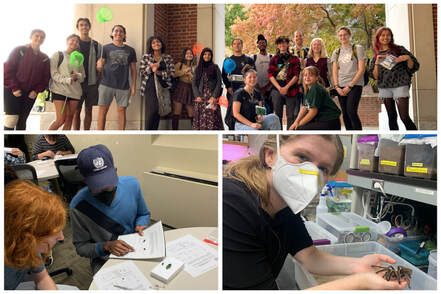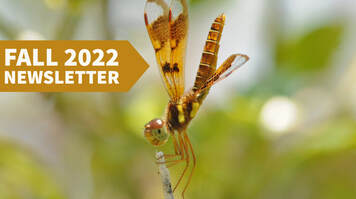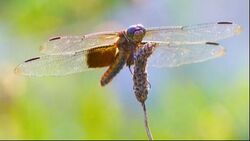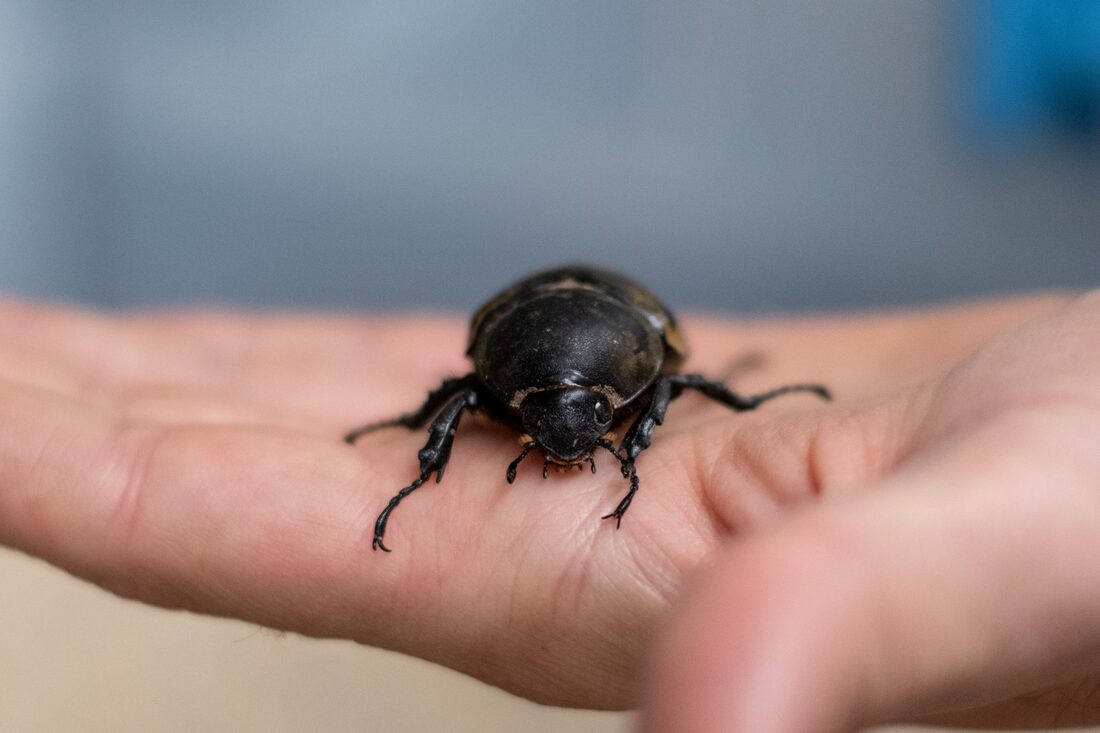|
written by: Ebony Michelle Argaez
Big data is the fuel of the 21st century, it is a part of our everyday lives; we produce and consume it. One example is the use of various types of data acquired from social media apps that are then used to deliver ads to targeted audiences. Yet, big data is also used in academia, health, science, and government for addressing research questions. What is big data? Big data can be measured by its volume, variety, and velocity. Big data contains high volume in the form of many individual observations. Variety refers to many attributes associated with these observations. Velocity is the repetition of that volume and variety across some other dimension (e.g., time or populations). When preexisting big data sets are used in ecological studies, it is called ecoinformatics [1]. Dr. Michael Crossley, an Assistant Professor and Agricultural Entomologist in the Department of Entomology and Wildlife Ecology at the University of Delaware, uses ecoinformatics to understand how insect ecology is affected by changes in agricultural landscapes. The Department of Entomology is pleased to announce Katy Evans and Arielle Arsenault-Benoit as the recipients of the first Charles F. Reichelderfer Memorial Mentorship Award for their outstanding impact on the professional development of their mentees. Each awardee made positive impacts on the academic ambitions of several people, but the mentorship of each was especially notable for inspiring an undergraduate student to pursue graduate work in Entomology. In fact, both mentees have now been accepted into a graduate program. We also recognize the positive impacts of two additional nominees with an Honorable Mention. Anthony Nearman and Maria Cramer provided much-valued and appreciated guidance to undergraduate and junior graduate students. We thank Katy, Arielle, Anthony and Maria for setting an important example in building a supportive professional community in our department.
Congratulations to the Fritz lab for their award winning posters at the Mid-Atlantic Mosquito Control Association (MAMCA) annual conference. UMD-SOARE student Sommer Stephens placed first, for her award winning poster, "Allele frequencies of Culex pipiens bioforms vary across an urban to rural gradient." When not messquitoing around in the Fritz lab for the summer, Sommer is a student at NC State majoring in Animal Sciences. Sommer's proud UMD mentor, Arielle Arsenault-Benoit, also placed in the poster competition with her work, "Spatiotemporal organization of cryptic North American Culex species along an urbanization gradient in greater Washington, D.C."
Link to MAMCA announcement: https://mosquito-va.org/scc-poster-competition facbook: https://www.facebook.com/UMDEntomology/posts/pfbid0KFt3UVwVW2eg9gbTjME1NWC5R3KRkm5MDw4wuc2V4rtZmjMz1rUKh3RJekWPVW5Gl twitter: https://twitter.com/UMDEntomology/status/1617938384651157505?s=20 written by: Taís Ribeiro and Brendan Randall
It is crucial for graduate students to learn how to design and execute scientific research. Using this research as an informative tool that affects both the livelihoods of people and addresses public needs is essential to communicating science. The ongoing educational partnership between the public and scientists is known as extension and it is one of the pillars of the Department of Entomology. At the first Entomology Research in Progress Seminars, we heard about the work of two researchers that not only perform scientific research but are actively involved in the dissemination and application of their research to solve problems faced by growers and the public. The postdoc Dr. Nathalie Steinhauer and her work in extension in Beekeeping operations, and the PhD Candidate Maria Cramer, who works in agricultural environments. Both of these researchers are passionate about teaching and learning from stakeholders by showing their scientific results and seeing how applied science affects people’s lives.  Photo Credit: Mohamed Sallam Photo Credit: Mohamed Sallam written by: Megan Ma This week’s colloquium speaker, Dr. Mohamed Sallam, is a disease and arthropod vector ecologist who has worked in a variety of positions. His previous appointments include working as a research scientist for developing integrated pest management programs, senior analyst at USEPA (United States Environmental Protection Agency), and entomologist for the U.S. Navy. His background has led him to a position in Bethesda, MD as an Assistant Professor at Uniformed Services University (USU), where he is mentoring students and facilitating safer conditions in deployed military environments and U.S. military bases. Specifically, he is seeking ways of preventing disease transmission by developing models to reduce arthropod-disease vector-host contact. This can include efficiently treating uniforms – identifying regions of the body that are more likely to be targeted by mosquitoes minimizes the cost of treating full uniforms while maximizing the protection of high-risk areas of vector-host contact. To consider the full range of environmental and public health hazards, Dr. Sallam emphasizes the importance of understanding micro- and macrohabitats. This begins with research that can link models with the biology of your organism of interest.  written by Leo Kerner We know that pollinators play a vital role in the health of every agroecosystem, but how can the agroecosystem benefit pollinators? Kathleen Evans, a PhD student in the Department of Entomology at the University of Maryland, is attempting to figure this out. Working in the EspíndolaLab, Katy is focused on plant-pollinator interactions and loves to engage with the public informing them of the importance of insects. She came to speak at our colloquium about her most recent project on floral diversification and its effects on beneficial arthropods and ecosystem services among edamame. Previously, Katy has worked on pollinator health in agroecosystems and sustainable honeybee management practices, and now her work takes a closer look at understanding plant-insect interaction in agroecosystems.  photo credit: Athanas photo credit: Athanas In Fall 22 a new club for insect-lovers formed on UMD’s campus, Bug Club. While there has long been interest in forming an undergraduate community group around arthropods, the First Look Fair really cemented the case that there was an abundance of excitement around forming a club. Sophia Athanas, undergrad and president of the club, said that at the Fair she, “noticed that students were very interested in arthropods and entomology (especially when giant millipedes were brought out!). However, many students either couldn’t fit any classes into their schedule or didn’t have the time to participate in extra academic activities, such as the honor’s thesis or minor. Forming Bug Club would solve this problem by providing a low-stress, no-commitment opportunity for students with even the smallest interest to see what entomology is like!”  Before you bug out for winter break, we invite you to look back at Fall 2022 with us. DYK, that a new club has #InsectTerp population on the rise? Or that today’s lab-raised honey bees have shorter life spans? Or that, we have a new faculty member starting soon - Dr. Niranjana Krishnan? These are just a few of the stories mentioned in the Fall 2022 newsletter. Content also includes news on publications, awards, defenses and much more. https://mailchi.mp/8bc2d06ef8ed/department-of-entomology-newsletter-fall-2022 PhD student Anthony Nearman and Associate Professor Dennis vanEngelsdorp discovered that life spans of lab-kept honey bees are 50% shorter than they were in the 1970s. The College talks to Anthony about this latest paper:
“When I plotted the lifespans over time, I realized, wow, there’s actually this huge time effect going on,” Nearman said. “Standardized protocols for rearing honey bees in the lab weren’t really formalized until the 2000s, so you would think that lifespans would be longer or unchanged, because we’re getting better at this, right? Instead, we saw a doubling of mortality rate.” Check out the full AGNR press release for more about the study and implications of the findings.  photo credit: Krishnan photo credit: Krishnan We are very pleased to announce that Dr. Niranjana Krishnan will joining the Department of Entomology as an Assistant Professor and Extension Specialist this coming Spring 2023. Niranjana joins us from the Missouri University of Science and Technology. Her work focuses on invertebrate toxicology and risk assessment. In her current research project Niranjana employs the adverse outcome pathway (AOP) principle to estimate the risk of pesticide exposures to insects, particularly species of conservation concern. This is being undertaken via three research themes that incorporate in vitro, in vivo, and in silico methods - AOP development from molecular initiating events to organismal effects, AOP development from organismal to population level effects and AOP employment to inform interspecies extrapolation. When not in the lab Niranjana enjoy reading and writing about toxicology (check out her blog EnTox Simplified), visiting National Parks, hiking on trails with her husband & dog and volunteering for initiatives that help teach science and promote diversity and inclusion. Please join us in welcoming Niranjana to the Department! It is with mixed emotions that we announce the retirement of Bill Katsereles effective Dec. 31, 2022. Bill has served in public higher education for 42 years with the University of Maryland (even more yrs. if we count his undergrad!). Bill Katsereles received his B.S. degree in accounting in 1980 from the University of Maryland, College Park. After graduating, Bill worked as an Accountant here at the University of Maryland’s Agricultural Experiment Station. A few years in (and a couple of cow purchases later) Bill was promoted to Business Manager at Wye Research & Education Center. In 1993, Bill started in the Department of Entomology where he has been instrumental in the financial administration and development of the department for the past 29 years.
[Seminar Blog] Serving the Public as a Government Scientist: Career tracks and opportunities11/18/2022
written by: Amanda Brucchieri and Robert Salerno
Have you ever thought of pursuing a career within the federal government? Do you know what opportunities exist for research, extension, and policy/regulation? During this week’s colloquium talk, Dr. Chris Peterson, an International Food Security, and Pest Management Professional working for the USDA Foreign Agriculture Service, passed on his knowledge and wisdom about career paths within the federal government. He wanted to bring a personal perspective to the field of government employment and help students navigate their next steps as future scientists so he came on his own time and was not speaking as a representative of the USDA. Dr. Peterson holds a Ph.D. in Entomology and Toxicology from Iowa State University and has held several positions within the Forest Service, Peace Corps, and currently, the Foreign Agricultural Service. The College talks to Dr. Espíndola about latest paper:
Climate change is taking a serious toll on insects, UMD Entomology's Anahí Espíndola and dozens of scientists from around the world warned in a new paper published by the Ecological Society of America. “We need to realize, as humans, that we are one species out of millions of species, and there's no reason for us to assume that we’re never going to go extinct,” Anahí said. “These changes to insects can affect our species in pretty drastic ways.” Link to full press release here>> Graduate Student Mariom A. Carvajal (Shultz Lab) co-authors report with Universidad de Magallanes researcher Eduardo I. Faúndez on the southernmost lacewing - Hemerobiidae. This documentation of Hemerobiidae extends the known distribution of lacewings about 110km further south than previously recorded. https://go.umd.edu/cKn
Registration open for The American Association for the Advancement of Science’s Charles Valentine Riley memorial lecture held Nov 30, 2022. Dr. Douglas Landis Michigan State University will present "Designing Pest Suppressive Agricultural Landscapes for a Changing World. '' Followed by panel discussion led by noted researchers, including ours truly, Dr. Megan Fritz, Asst Prof, University of Maryland. Register for the event: https://www.aaas.org/riley-lecture
Share on twitter and facebook written by: Ben Burgunder & Eric Hartel
How can modeling and mathematics inform our research of macroevolution? Towson University professor Dr. Daniel Caetano visited the University of Maryland's entomology department to deliver a lecture on his many research interests. Dr. Caetano explores evolution through mathematical modeling and novel approaches to phylogenetic comparative methods. Phylogeny is the scientific approach to understanding the evolutionary relationships between groups of organisms and phylogenomics is the application of genomics to phylogenetics research. Dr. Caetano explained that his research is supported by two pillars: trait evolution and species diversification. He discussed two examples of developing novel methodology from published, publicly available datasets. written by: Minh Le
Not many people have heard of the sorghum plant, so you might be surprised to know that it is grown in 21 states (Figure 1)! The “Sorghum Belt”, or area comprising states that have abundant sorghum production, stretches from South Dakota all the way down to southern Texas (National Sorghum Producers). The sorghum plant produces nutritious grain, which is an important ingredient for livestock feeds as well as a whole grain alternative to people with low gluten tolerance or who suffer from celiac disease. Besides its nutritional benefits, sorghum production can have a positive impact on the environment and sustainability efforts, as the sorghum bushels can be extracted for ethanol, a renewable source of fuel, and require one-third less water to grow compared to other feedstocks (National Sorghum Producers). Despite its agricultural and environmental importance, as with other widely cultivated agricultural crops, these plants are a buffet for pest insects whose voracious appetite cause significant economic damage every year. A prominent invasive pest feeding on sorghum in the US is the sorghum aphid (Melanaphis sorghi). These insects use their syringe-like mouthparts to pierce and suck juices from plant tissues, damaging them. In 2013 and 2014, it is estimated that these aphids caused 50 to 100% of crop loss, and in 2015, sorghum producers in the Rio Grande Valley lost approximately 31 million dollars. The entomology colloquium welcomes Dr. Jocelyn Holt, a researcher at Rice University, Texas, who provided insight into her research on the population genetics of sorghum aphids across the US and the symbiotic microbiota that is associated with them. Varroa mites and viruses they vector are leading causes of honeybee losses. University of Maryland researchers Drs Eugene Ryabov (Bee Lab) and Zachary Lamas (Hawthorne Lab) team up with U.S. Department of Agriculture to study varroa mite infectiousness and the effect of the vectored viruses on varroa survival. Last month they published their findings in Frontiers in Insect Science entitled, “The vectoring competence of the mite Varroa destructor for deformed wing virus of honey bees is dynamic and affects survival of the mite.” The authors hope this work will provide new insights into the varroa mites' impact on colony disease and ways to manage it.
Link to paper: https://www.frontiersin.org/articles/10.3389/finsc.2022.931352/full University of Maryland PhD candidate Kyle D. Brumfield and Drs. Rita Colwell and Michael Raupp, teamed up with colleagues from the University of Connecticut-Storrs, University of Connecticut-Hartford, University of California Berkeley, and EZbiome, Inc. to explore the rich diversity of the gut microbiome of periodical cicadas. For those interested in learning more about their research into these remarkable insects, check out publication out this week in Scientific Reports.
Link to article: https://www.nature.com/articles/s41598-022-20527-7 Prof Emeritus Mike Raupp tells the The Weather Channel yes, ants are indeed abundant, reaching every continent except for Antarctica. "They outweigh birds and all wild mammals which is is simply a huge huge amount of mass" Raupp says. & not only are the sheer # and distribution of ants amazing but so is the extraordinary contributions ants make to our planet. Learn more here: written by: Darsy Smith and Benjamin P. Gregory
How do insects that live in dry environments like deserts keep from drying out, and how might these adaptations help them adjust to our constantly changing world? For our first colloquium of October, the Entomology Department welcomed Dr. Henry Chung, an assistant professor at Michigan State. Dr. Chung’s research investigates the genetic mechanisms underlying insect adaptations to different environmental conditions, particularly dry ones. Just like humans, insects need water to live their lives, so making sure they don’t dry out–or desiccate–is vital to their survival. So how do insects that live in hot and dry conditions prevent desiccation? One of the most important pieces of an insect’s defense against desiccation is its epicuticle, the waxy top layer of its exoskeleton, and the chemical pieces that make up this epicuticle, called cuticular hydrocarbons (CHCs). Spiders of the genus Steatoda, known as false black widows, have a resemblance to the black widow but are less harmful. However, around the world, there has been an increase of reports that this "less harmful" genus has been causing quite a debilitating bite. Heightened public concern has researchers, like grad student Mariom Adriana Carvajal (Shultz Lab), revisiting this genus. Mariom has been studying 1 of the 7 species found in Chile, taking a second look at its characteristics and its distribution. Today, Mariom and collegues published some of that work in Revista Chilena de Entomología, entitled, “A new record of Steatoda porteri in Chile.” Their findings show that although Steatoda porteri has extended its range, it remains outside urban areas for now.
written by: Alireza Shokoohi
What are you passionate about? Dr. Carlos Blanco may be a Senior Entomologist at the U.S. Department of Agriculture, handling the international import and domestic movement of insects, but he still spends much of his own time conducting research. Early in the mornings and on weekends, he can be found in crop fields collecting data to answer questions about a subject he is passionate about: corn.
|
Categories
All
Archives
March 2024
|
Department of Entomology
University of Maryland
4112 Plant Sciences Building
College Park, MD 20742-4454
USA
Telephone: 301.405.3911
Fax: 301.314.9290
University of Maryland
4112 Plant Sciences Building
College Park, MD 20742-4454
USA
Telephone: 301.405.3911
Fax: 301.314.9290




 RSS Feed
RSS Feed




